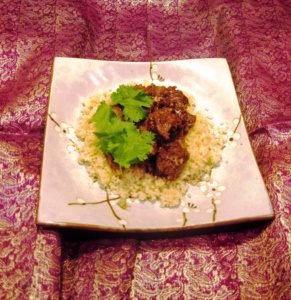A carob tree and a wellspring of water have been called miracles that have sustained sages and prophets alike. The slow maturation and flowering of the carob tree also teaches one to invest in the future even when it is arduous and promises no immediate gains. The carob is staple that provides sustenance, the promise of the next generation, and is incredibly tasty when cooked in a stew with lamb.

What the carob does do is make a savory stew even more savory, and in the case of my creation, it blanketed the sharp edges of the added cumin and corainder seed. I feel justified in adding the cumin and coriander because in most of the modern world, recipes still don’t list each and everything that goes into the pot – that is a sort of rigor and precision that is uniquely a western European and American expectation. All over the world, ingredients are left unspecified to allow for creativity of individual cooks or just to use what they have on hand. If you are interested in this concept of culinary variation, check out my post Viva Variation. For justification of the use of carob and semolina, see my growing lexicon of Mesopotamian food terms. But I digress. . .
__________
Lamb and Carob Stew
Buttery-soft and delectable halal lamb fresh from the farm is spiced with ground coriander and cumin seeds and sauteed in light sesame oil. The shallots are added and lightly caramelized. The stew is then given an incredible depth of flavor by the addition of ground carob powder. Then it is lifted by the addition of leeks and garlic mashed with whole milk yogurt and served on a bed of semolina couscous cooked and steamed over homespun lamb stock. As superb today as it was almost 4,000 years ago.
Ingredients
1-1.3 pound lamb roast, cut into bitesize pieces
1 tablespoon coriander seeds, freshly ground
3 teaspoons cumin seed, freshly ground
2-3 tablespoons light sesame oil (gingelly)
6 medium shallots, peeled and sliced
2 -3 cups of water
2-3 generous tablespoons of carob powder
1 teaspoon salt (or to taste)
1 leek (both white and green parts), carefully cleaned and rinsed
6 cloves of garlic, peeled
1 cup of yogurt
Serve over couscous – cooked separately as desired.
Directions
Flavor lamb with half of the ground coriander seeds and about 1 teaspoon of ground cumin seeds. Massage the spices around and into the meat as possible. Let stand for several hours or overnight to really flavor the meat.
Heat light sesame oil in a large saucepan and sear the seasoned lamb until opaque and just beginning to color around the edges. Reduce heat, remove meat from pan and set aside. Add sliced shallots and cook over low heat until the start to caramelize. Caramelization will happen more quickly if you don’t stir or otherwise disturb the shallots too much.
When shallots are done to your liking, add the remainder of the ground coriander and cumin seed and cook to warm the spices, 3-5 minutes. When spices are warm and aromatic, add water. (Start with 2 cups and add more if needed or desired after meat is added.) Cook to warm water. When water is hot, add meat and stir. Cover and cook over medium heat for 5-10 minutes to bring meat up to temperature. Add carob powder and salt and stir well. if the carob clumps, break it up. Recover and cook over medium or medium-low heat until lamb is soft, stirring occaisionally. The exact amount of time will depend on how large you cubed the lamb, but should be about 40 minutes or so. Watch the heat so that the lamb doesn’t burn, lower heat if necessary.
Prepare couscous as desired while the lamb is cooking.
When lamb has almost softened, uncover and cook for about 5- 10 minutes. In a food processor, pulse the leek and garlic until a diced vegetable is achieved. Add yogurt and pulse once or twice more to mix. Don’t blend until mush, the crunch of the vegetable is desired.
Add to the stew and stir well. Cook uncovered stirring occaisionally until stew is hot once again. Serve over couscous and garnish with fresh cilantro.
__________
A word or two about my choices. I chose lamb, simply becasue I like it, but almost any meat will work with this recipe. I chose a stew, but many other options are available – a braised dish, a cooked shank, or even a roast that is first boiled. I also flavored the meat with the dry spice rub to increase the impact of the coriander and cumin flavor on the stew. In the first test run of this recipe, I added the spices only to the stew and they were not as prominent as when added to the meat before cooking and in the stew.
For the form of semolina, I chose couscous – simply because it was a form of semolina and would be tasty with the lamb stew. Other options could include a ground and lightly roasted semolina to thicken and add flavor to the stew (much as roasted rice is used in SE Asian dishes today), or coating the meat prior to searing with a semolina and spice mixture – sort of like spiced breadcrumbs might be used today.
I chose to integrate the yogurt, leek and garlic mixture into the stew, much as one would add yogurt to an Indian curry. However, other choices could include as a condiment for diners to add at will to the stew, or even a dip for breads that accompany the meal. Adding the blend into the stew adds great texture with the crunch of the vegetables as well as little blasts of additional flavor when diners bite into them.
Other dishes and combinations are doable and I hope will be done by others. This is only one possibility for the nineteenth “recipe” listed on the Yale Babylonian Tablets – there are many other culinary creations to make, such as lamb ribs or chops with carob sauce, braised lamb with carob, or even a soup. But clearly this is much more than just another meat broth as envisioned by Bottero. (Words and recipe for Lamb and Carob Stew by Laura Kelley. Photo of Carob Tree by Ivlys; Photo of Lamb and Carob Stew by Laura Kelley.)


Thank you so much for this recipe. I am researching the carob here in Crete and I will definitely try this recipe and post a pic if I do 🙂 best wishes. (oh great project by the way. love the site!)
Hi Reema:
Let me know how it goes! And you can modernize it if you want to: grill lamb chops or kebabs and make a light carob sauce for them. The Yale tablets are really just ghuidelines for flavors and ingredients that go together. There seems to be a lot of variation allowed in recipes. Think an episode of iron chef! Good luck! Laura
What a gorgeous recipe! I am a vegetarian, but you have written this so generously, I am inspired to play. And PLAY, I shall!
All the best for the New Year.
Thanks L!
Let me know if you have questions about the recipes or post content.
Laura